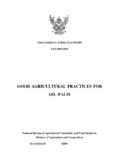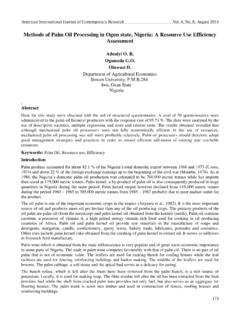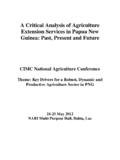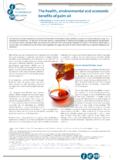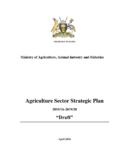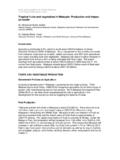Transcription of Soybean International Commodity Profile - World Bank
1 Background paper for the Competitive Commercial Agriculture in Sub Saharan Africa (CCAA) Study Soybean International Commodity Profile Prepared by P. Thoenes Markets and Trade Division Food and Agriculture Organization of the United Nations Disclaimer: This background report is being made available to communicate the results of Bank-funded work to the development community with the least possible delay. The manuscript therefore has not been prepared in accordance with the procedures appropriate to formally edited texts. Some sources cited in this report may be informal documents that are not readily available. The findings and interpretations expressed in this report are those of the author(s) and do not necessarily reflect the views of the Board of Executive Directors of the World Bank or the governments they represent, or those of the Food and Agriculture Organization of the United Nations (FAO).
2 The World Bank and FAO do not guarantee the accuracy of the data included in this work. The designations employed and the presentation of the material in this work, including the boundaries, colors, denominations, and other information shown on any map do not imply any judgment on the part of the World Bank or FAO concerning the legal status of any territory or the endorsement or acceptance of such boundaries. 2 Soybean : International Commodity Profile 1 1 Introduction Over the last 20-30 years, consistent improvements in average yield levels and reductions in production costs have steadily improved the competitive position of soybeans among arable crops. Among oilcrops, Soybean covers a leading role at the global scale: today, soybeans account for about 35% of total harvested area devoted to annual and perennial oilcrops.
3 The crop s share in global oilseed output is estimated at over 50 %. Soybean cultivation is highly concentrated geographically, with only four countries - USA, Brazil, Argentina and China - accounting for almost 90 % of World output. Asia - excluding China - and Africa, the two regions where most of the food insecure countries are located, together account for only 5 % of production. Among countries classified as undernourished, only India and Bolivia are significant producers of soybeans. Soybean is a high value and profitable crop. The economic viability of soy production is determined by the commercial utilization of both its sub-products, meal and oil, which, respectively, account for about two thirds and one third of the crop s economic value. Soyoil and meal are consumed worldwide as food and animal feedstuff respectively.
4 Soymeal accounts for over 60 % of World meal production (vegetable and animal meal) and occupies a prominent position among protein feedstuffs used for the production of feed concentrates. Soybean oil is the second most important vegetable oil (after palm oil); it accounts for 25 % of global vegetable/animal oils and fats consumption. The widespread use of Soybean oil in particular as edible oil is due to its plentiful and dependable supplies, its competitive price, and its neutral flavour and stability in both unhydrogenated and partially hydrogenated form. Moreover, the rapid rise in the demand for compound feed - und thus soya meal - has contributed considerably to the rise in soyoil production. Oil palm is a major competitor with Soybean oil. Although the palm produces far more oil per unit area than Soybean , Soybean s role is expected to be secure because soya meal is in huge demand and oil is a very lucrative by-product.
5 It is also true that oil palm is generally grown in different ecologies than Soybean , so there is a certain amount of geographical complementarity. A particular feature of the Soybean economy is that considerable value addition occurs at the downstream stages of the production and processing chain. On-farm storage of Soybean plays a minor role and small-scale processing and marketing at local level is only relevant in those - statistically less important - regions where soybeans are directly consumed as food. At the global level, the bulk of Soybean output is stored and shipped in bulk to large-scale industrial units for further processing into oil and meal. Down-stream transformation and subsequent (export oriented) marketing of the end-products are separate economic activities that generate considerable value outside the agricultural sector per se, explaining the economic importance of Soybean for the global food and feed industry.
6 In the major producing countries and particularly in Brazil, Argentina, Paraguay and the USA Soybean contributes significantly to the total value added by the agricultural sector. In these countries, soybeans and its sub-products also occupy an important position in total export earnings. Among smaller producers only India and Bolivia earn significant income from the exportation of Soybean and derived products. 1 Prepared by P. Thoenes, Trade and Markets Division, Food and Agriculture Organization of the United Nations. Statistical assistance was provided by Marco Milo. 3 At the farm household level, the bulk of the World s Soybean production comes from medium to large-size farms that are characterized by capital intensive production methods and a high level of mechanization.
7 In addition to producers in North America, this also applies to the average Soybean farm in South America. The situation is different, however, in Asia (China, India, Indonesia, Japan, PDR of Korea, Thailand, Vietnam) and in Africa (Uganda, Nigeria), where Soybean tends to be produced - sometimes predominantly - on a smaller scale, involving labour intensive cultivation methods. In these regions, the contribution of soybeans to the food security of small rural households tends to be relatively more significant, albeit its overall importance remains low due to the crop s limited role in total cultivated area. 2 Market Structure Production pattern and related issues Soybean (Glycine max L. Merr) has been grown as a commercial crop primarily in temperate ecologies for thousands of years, first in northern Asia and in more recent decades in North America and countries of the Southern Cone of Latin America.
8 Agronomic advances have led to dramatic growth in the supply and utilization of soybeans worldwide since the Second World War. Best crop yields are obtained between latitudes 30 and 45 degrees on either side of the Equator. Today, the share of Soybean in global oilseed production averages around 55 %, and over the last ten years World Soybean production has expanded at a rate of over 5 % per year on average (see figures in Appendix table 1). The USA, Brazil and Argentina account for a combined 82 % of global output; they are followed, at considerable distance, by China, India and Paraguay, which, together, account for another 13 percent of World production. Among these countries, production has expanded fastest in Argentina and Brazil; in the USA, China and India growth has been considerably slower.
9 The list of Soybean growing countries includes several other, smaller producers; countries where production has expanded at an above average rate include Bolivia, Uruguay, the Republic of South Africa, Uganda, Romania, the Ukraine, the Russian Federation and Vietnam. Biotechnology Soybean is one of the crops where recent advances in biotechnology applications have been particularly important. Consequently, commercial production of genetically modified soybeans has risen sharply in recent years, with important repercussions for production, consumption and trade. In the World s three largest producing countries, the USA, Brazil and Argentina, about 70-90 % of Soybean produced consists of GM varieties. On the consumption side, the advent of GM soybeans and other food crops has created considerable debate following consumer concerns about the safety of GM products.
10 Although production and marketing of GM products are increasingly regulated by national policies to guarantee biodiversity, biosafety and, in particular, food safety, policies tend to differ considerably between countries, with important implications for trade, notably the development of distinct processing and marketing chains for GM and non-GM soybeans and products (see also below section on policies). Sustainability concerns In recent years, concern has grown about expansive mono-crop Soybean in fragile ecologies such as the savannahs of Brazil. Some of these problems are being addressed by changes in production practices of farmers with technical support from research institutions. One of the biggest improvements is the rapid farmer adoption of zero tillage technologies in both North and South America.










